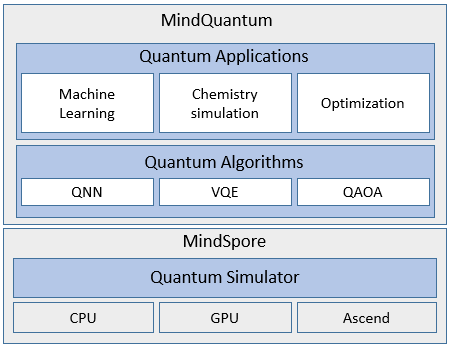- MindQuantum
MindQuantum is a general quantum computing framework developed by MindSpore and HiQ, that can be used to build and train different quantum neural networks. Thanks to the powerful algorithm of quantum software group of Huawei and High-performance automatic differentiation ability of MindSpore, MindQuantum can efficiently handle problems such as quantum machine learning, quantum chemistry simulation, and quantum optimization, which provides an efficient platform for researchers, teachers and students to quickly design and verify quantum machine learning algorithms.

The below example shows how to build a parameterized quantum circuit.
from mindquantum import *
import numpy as np
encoder = Circuit().h(0).rx({'a0': 2}, 0).ry('a1', 1)
print(encoder)
print(encoder.get_qs(pr={'a0': np.pi / 2, 'a1': np.pi / 2}, ket=True))Then you will get,
q0: ────H───────RX(2*a0)──
q1: ──RY(a1)──────────────
-1/2j¦00⟩
-1/2j¦01⟩
-1/2j¦10⟩
-1/2j¦11⟩In jupyter notebook, we can just call svg() of any circuit to display the circuit in svg picture (dark and light mode are also supported).
circuit = (qft(range(3)) + BarrierGate(True)).measure_all()
circuit.svg()ansatz = CPN(encoder.hermitian(), {'a0': 'b0', 'a1': 'b1'})
sim = Simulator('projectq', 2)
ham = Hamiltonian(-QubitOperator('Z0 Z1'))
grad_ops = sim.get_expectation_with_grad(
ham,
encoder + ansatz,
encoder_params_name=encoder.params_name,
ansatz_params_name=ansatz.params_name,
)
import mindspore as ms
ms.set_context(mode=ms.PYNATIVE_MODE, device_target='CPU')
net = MQLayer(grad_ops)
encoder_data = ms.Tensor(np.array([[np.pi / 2, np.pi / 2]]))
opti = ms.nn.Adam(net.trainable_params(), learning_rate=0.1)
train_net = ms.nn.TrainOneStepCell(net, opti)
for i in range(100):
train_net(encoder_data)
print(dict(zip(ansatz.params_name, net.trainable_params()[0].asnumpy())))The trained parameters are,
{'b1': 1.5720831, 'b0': 0.006396801}-
Basic usage
-
Variational quantum algorithm
-
GENERAL QUANTUM ALGORITHM
For more API, please refer to MindQuantum API.
- The hardware platform should be CPU with avx2 supported.
- Refer to MindQuantum Installation Guide, install MindSpore, version 1.4.0 or later is required.
- See setup.py for the remaining dependencies.
1.Download Source Code from Gitee
cd ~
git clone https://gitee.com/mindspore/mindquantum.git2.Compiling MindQuantum
cd ~/mindquantum
bash build.sh
cd output
pip install mindquantum-*.whlPlease refer to MindSpore installation guide to install MindSpore that at least 1.4.0 version.
pip install mindquantumSuccessfully installed, if there is no error message such as No module named 'mindquantum' when execute the following command:
python -c 'import mindquantum'Mac or Windows users can install MindQuantum through Docker. Please refer to Docker installation guide
Please set the parallel core number before running MindQuantum scripts. For example, if you want to set the parallel core number to 4, please run the command below:
export OMP_NUM_THREADS=4For large servers, please set the number of parallel kernels appropriately according to the size of the model to achieve optimal results.
If you would like to build some binary wheels for redistribution, please have a look to our binary wheel building guide
For more details about how to build a parameterized quantum circuit and a quantum neural network and how to train these models, see the MindQuantum Tutorial.
More details about installation guide, tutorials and APIs, please see the User Documentation.
Check out how MindSpore Open Governance works.
Welcome contributions. See our Contributor Wiki for more details.
When using MindQuantum for research, please cite:
@misc{mq_2021,
author = {MindQuantum Developer},
title = {MindQuantum, version 0.6.0},
month = {March},
year = {2021},
url = {https://gitee.com/mindspore/mindquantum}
}